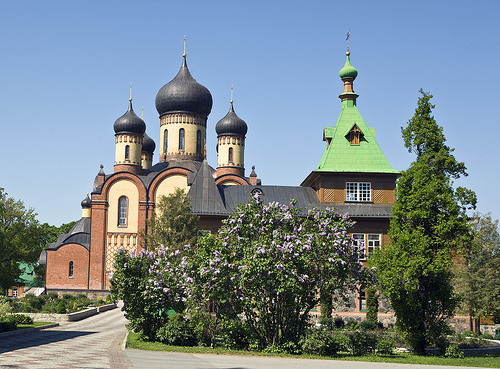

Location: Ida-Viru County Map
Found: 1891
Puhtitsa Convent is a Russian Orthodox Monastery that is located in Ida-Viru County in Eastern Estonia. The name of Puhtitsa Convent is derived from Estonian word Pühitsetud that means "blessed". Several Estonians witnessed and talked to Holy Virgin on the mountain. Puhtitsa Orthodox monastery was established in 1891. Over 200 nuns eventually settled here establishing a hospital for the poor and the peasants who lived in the vicinity of the abbey. Everyone was accepted regardless of nationality or religion.
After Soviet Revolution Estonia became independent for a brief period. After the end of the World War II Baltic states were added to the USSR. Puhtitsa Convent remarkably remained open despite numerous attacks of the atheistic government. In fact organized attacks against religion and this abbey in particular had the opposite effect. Many young women came here to be ordained as nuns.
A very old tradition is recorded in the chronicle of
the skeet of the Prophet Elijah of Vasknarva. According to this, an
Estonian shepherd saw a great woman surrounded by radiant light on
Kuremäe. The vision was repeated on several days and many people came to
see it. Where the miraculous vision had stood, people found the icon of
the Dormition of the Mother of God under the tree.
The icon was
presented to the Orthodox of Jaama village. Orthodox believers received
the revealed icon with gratitude and devotion, and it has been preserved
in the Kuremäe monastery through wars and famines. Regarding the vision
seen in the 16th century and the finding of the icon, Peeter Kaldur has
expressed the opinion that it was the remains of the forest chapel of
the descendants of the Vadja people. According to this, the mountain is
called Pühtitsa, or consecrated place.
It is known that there was an Orthodox chapel on
Kuremäe from 1608.
In 1888, the Orthodox Church sent nun Varvara
(Blohhina) from the Ipatjev Monastery in Kostroma, accompanied by three
sisters, to Virumae to treat the sick. In 1891, permission was given to
establish a nunnery in Pühtitsa (Russian: Пюхтицкий Успенский женский
монастырь), whose first abbess was Mother Varvara. The patron of the
building was Prince Sergei Shahhovskoi, Governor General of Estonia. The
main church of the monastery was built on the site where the Lutheran
Illuka church was under construction. The material from the Illuka
church was partly used in the construction of the new church. It was the
first Orthodox monastery established in Estonia. In 1895, the archbishop
of Riga and Miitav Arseni (Bryantsev) consecrated two churches in the
monastery: the church of Saints Simeon and Anna and the church of Saint
Sergius.
The buildings of the monastery were built with the whole
in mind: the nuns' residences, the winter church-dining house, the
hospital, the Cathedral of the Dormition of the Mother of God, the bell
tower of the gate, the school and the inn. In the monastery garden, an
oak grows with a trunk diameter of 4.3 meters. It is a sacred tree among
believers.
The most important building of the monastery is the
five-domed Assumption (Uspensky) main church of the Mother of God,
imitating the sacred buildings of the Moscow-Yaroslavl school, which was
built in 1908-1910. Its architect was Alexander Poleshchuk. The
three-aisled church has three altars, a rich iconostasis carved from
pine wood and rare wall paintings. There is room for 1200 people.
In the years 1917-1923, the monastery was evacuated to Rostov in the
Yaroslavl province, during the War of Independence, the monastery
buildings housed a typhus hospital. After the independence of Estonia,
the Estonian government confiscated most of the lands of the monastery
in 1919 and subordinated it to the Estonian Apostolic Orthodox Church,
which did not submit to Moscow from 1923.
During the Second World
War, the front line passed just a few kilometers from the church, and
the Germans established the Kuremäe concentration camp near the
monastery.
1892–1897 Varvara
1897–1921 Alexia
1921-1943
Joanna
1943–1946 Alexia
1946–1955 Raphael
1955-1967 Angelina
1968–2011 Varvara
2011 – Filareta
Plan of the Puhtitsa Convent (taken from Official site)
1. The Dormition Cathedral 1910
2. The Refectory Church of Sts.
Symeon and Anne 1895
3. St. Sergius Church 1895
4. The Cemetery
Church of St. Nicholas and St. Arsenios the Great 1885
5. The Holy
Gates of the Convent with the bell-tower 1893
6. The Belfry of the
St. Sergius Church 1988
7. The Church of St. John the Baptist and St.
Isidore, the Hieromartyr (a baptistery) 1990
8. The Convent's
official residence (guest-house)
9. The Church of St. Alexius and St.
Varvara, the Great-martyr /within the alms-house of the Convent 1986
10. The Ancient Chapel by the oak-tree
11. St. George's Chapel 1989
12. Cell-houses. Work-shops. Maintenance-buildings
13. The Convent
Hostel